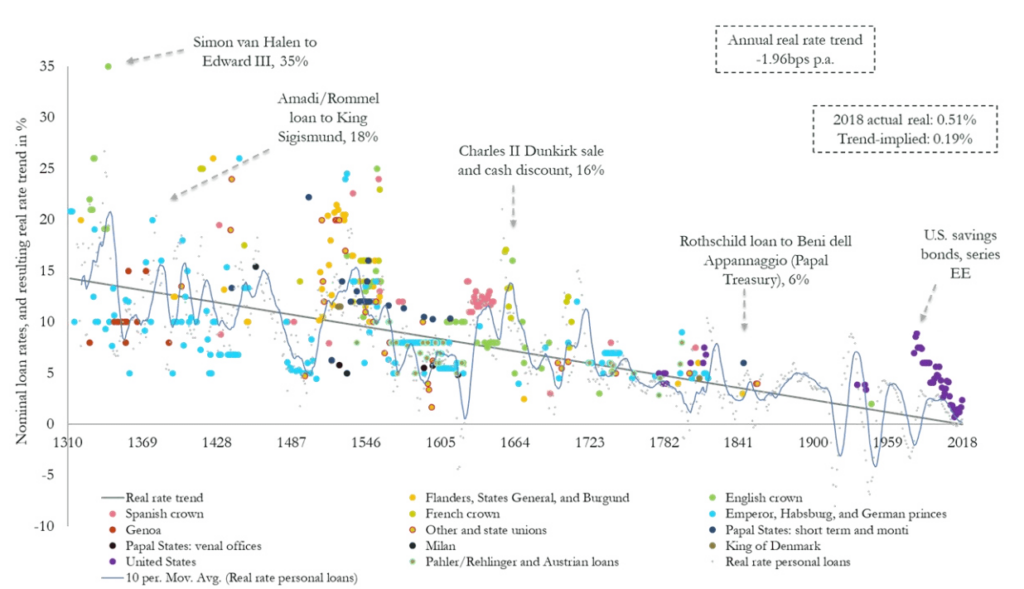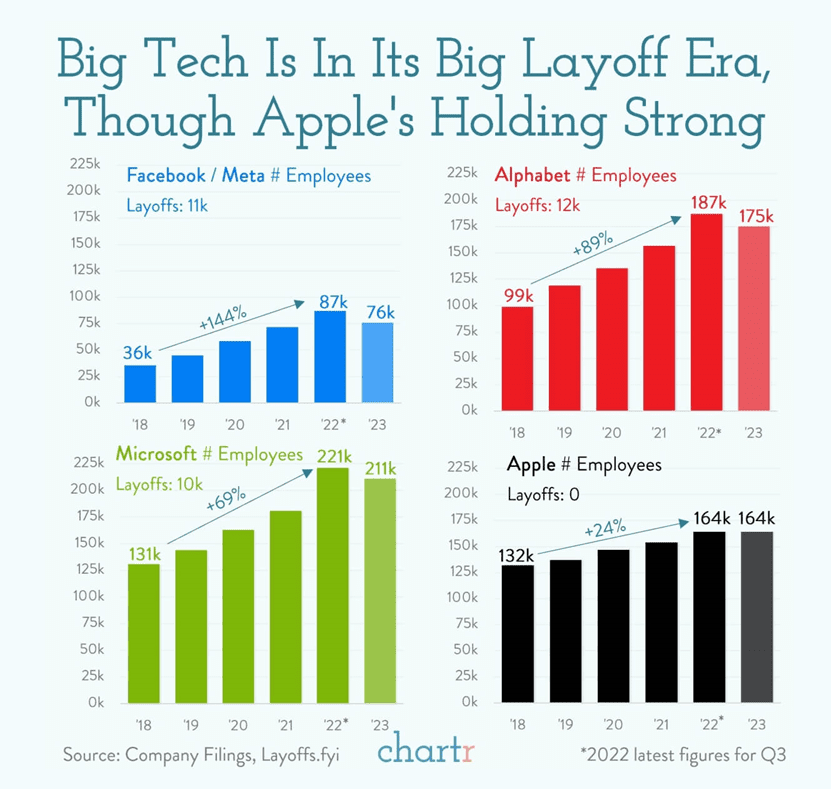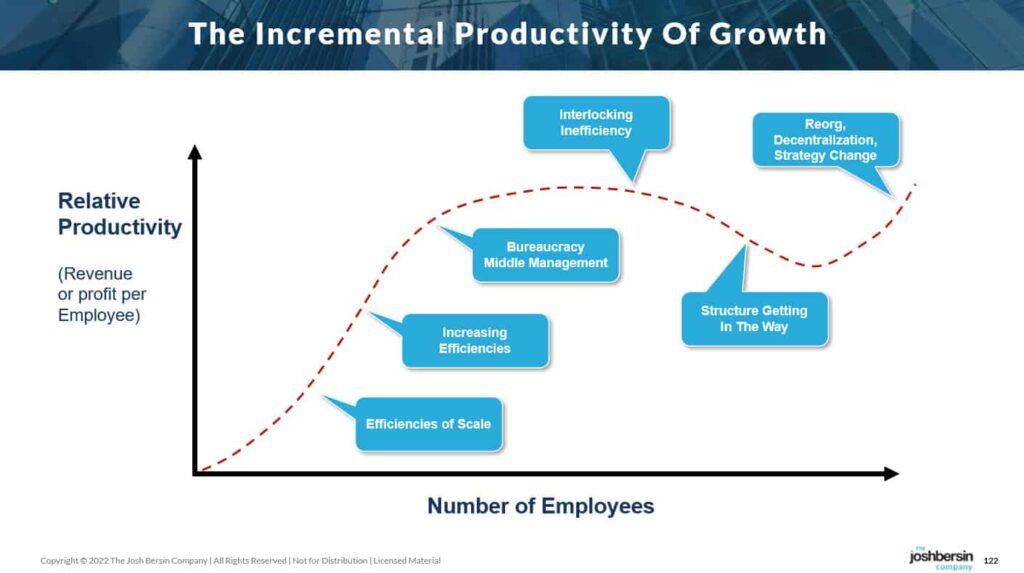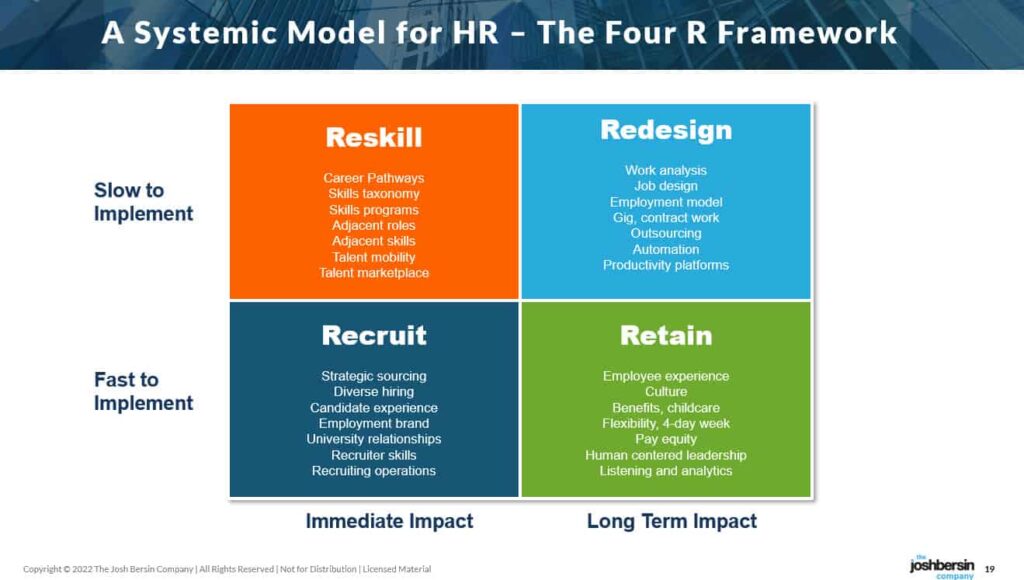Written by Josh Birsen – Published on JoshBersin.com
As most of you know, the technology industry has laid off more than 200,000 people in the last six weeks and each week we see more (this week it was Intel, Paypal, Splunk, and Pinterest). So let me ask an important question: were all these layoffs inevitable?
Well in order to answer this question we have to talk about micro-economics: how companies work.
Let’s go back a few years and look at what was happening. Starting around 2009 we entered a strange economic period: interest rates were cut to zero, money was essentially free, and investors and CEOs felt that risk taking was rewarded. (Several economists estimate that this was the lowest interest rate period in 700 years.)

As a result of this “risk-free capital,” technology companies (and others) were flooded with capital, expecting ever-increasing billion dollar valuations. So they hired as fast as they could.
As a result of this “risk-free capital,” technology companies (and others) were flooded with capital, expecting ever-increasing billion dollar valuations. So they hired as fast as they could.
The biggest firms, like Google, Meta, Amazon, Salesforce, and Microsoft, expanded rapidly, trying to keep up with their peers. Most of the HR Tech companies I work with told me their investors were breathing down their necks to hire, demanding they scale up quickly. (Note the hiring sprees below, and how Apple avoided the hiring boom and also the layoffs.)

What Happens When A Company Goes On A Hiring Spree?
What happens when a company grows this fast? A hiring spree creates a flywheel effect, and it’s often hard to slow it down.
First, the CEO and CFO create a growth budget, delegating headcount to business units. Business units allocate headcount to line managers, who then create job requisitions. The HR team considers these “orders” and immediately starts posting positions, sourcing, recruiting, and hiring. (During 2020 and 2021 “recruiters” became the most in-demand talent in tech.).
The Talent Acquisition team writes job descriptions, looks at candidate pools, and rapidly invests in sourcing, recruiting, interviewing, and screening. There is a frenzy of activity among hiring teams and managers are deluged with interviews. (Many managers hate this, by the way, so they don’t take it seriously enough.)
In a rush to grow, this process gets accelerated. “Time to hire” becomes the measure of success so companies raise salaries to get candidates to make decisions quickly. (Meta was paying more than $500,000 a year for “people analytics” specialists, for example.)
And this flywheel keeps spinning, getting messier over time. Hiring managers become flooded with new people and they struggle to put people to work. So productivity, the whole goal of hiring, starts to decline.
While most managers love to hire, they typically aren’t experts at organization design and goal setting. So when a new person joins they do their best to onboard them, allocate work, and get them up to speed. But this takes time. I know a top notch tech firm, for example, who hired dozens of “sales engineers” who sat on the bench for months, waiting for new deals to close.
And this gets to the next challenge: hiring ahead of revenue. Ambitious companies believe they can “hire to grow.” Execs bring in sales, marketing, and product people and expect revenue to quickly follow. Hiring is not done to “meet demand” it’s done to “create demand.” And that, unfortunately, creates more risk.
I’ve worked for five fast-growing companies in my career and the “hire to grow” model is riddled with challenge. The faster you grow the harder it is to sustain productivity because senior people are overloaded with onboarding. Managers are busy hitting their targets so they delegate onboarding to HR or other senior team mates. And to try to avoid this problem, people hire “over-qualified” people with the hope they get on board quickly.
In reality, however, a company with lots of new people (note how the tech firms above grew at 70-90%) has lots of confusion to address. New people working for other new people, new systems to buy, and lots of issues for managers to address. And in my experience it always takes months to quarters before a new employee truly understands the company. (This image describes the cycle.)

What happens next? Revenues slow, and now the CEO and CFO are upset. How did we get our cost structure so high? What are all these people doing? Who hired all these people and why aren’t they trained? There’s lots of blame to go around.
You can imagine what’s next. There’s a lot of hand-wringing, sometimes some weeping, and finally the CFO says “we have to cut back.” So the “hire to grow” ideas go out the window and the team looks at options to cut back, increase productivity, and reduce cost. Should we cut pay? Stop hiring? That’s all to slow. So now it’s time for a layoff. (Note that this week Intel announced that top leaders would take the highest pay cuts.)
Next come layoff notices, emails, exit packages, notifications to investors, and PR damage control. And so starts a process of rebuilding culture, trying to maintain brand strength, and telling survivors what’s next. And as I’ve experienced several times, the “survivors” are often stunned.
How Can Companies Prevent This?
Well to state the obvious, this doesn’t necessarily have to happen. If you grow more slowly and constantly focus on increasing productivity, you can often avoid this fate. Here’s what we’ve learned.
Many industries face rapid changes in demand. (Healthcare, consumer goods, retail.) These companies learn that “hiring to grow” is simply not sufficient. So they embark on what we call a “systemic HR” model: combining recruiting, retention, reskilling, and job redesign in a continuous process.
Rather than simply throwing headcount into the Talent Acquisition order book, these companies try to dynamically move people from low growth to high growth areas (development and mobility). They create a culture of growth and development (career models, capability academies). They improve employee experience continuously (increasing retention and productivity). And they regularly look for ways to automate, reduce routine work, and re-engineer business processes. We call this the “Four R” Framework for HR.

Consider how hospitals deal with demand. Facing a tremendous shortage of nurses, they have re-engineered scheduling, clinical processes, check-in, exit, and almost every business process. (Read more here.) Consumer Package Goods companies are similar. Companies like Nestle, Unilever, General Mills, and PepsiCo regularly move people from product team to product team and function to function as consumer needs change. Of course they hire, but they are much more deliberate about internal mobility, forcing the company to build development plans and growth into the system.
How To Continuously Increase Productivity
After almost 30 years working with HR teams, I’ve seen this again and again. During the 2008 downturn, most companies slashed indiscriminately to reduce costs. While this was a survival tactic for many, some rebounded quickly. Companies like Southwest Airlines, Cisco, and even IBM recovered more quickly than we expected. This was largely because they had more “systemic” people processes in place.
If you read my new book Irresistible: The Seven Secrets Of The World’s Most Enduring, Employee-Focused Organizations, you can see the recipe for endurance. Hire slowly, focus on culture, and stay deliberate and relentless in your pursuit of employee productivity, growth, and skills.
And let me add even more incentive. Many academic studies have proven (here, here, and here) that layoffs do not increase stock price. In fact quite a few studies show the opposite: they damage brand, culture, and long-term growth. So try to stay rational during the boom times, and you’ll be more resilient during tough times.
Creating A Systemic Model Of Growth
So let me conclude with this. These games are over for a while. We’ve benefited from 15 years of growth, and now it’s time to ratchet back. And as Warren Buffet and most long term investors understand, a high value business has endurance, staying power, and resilience.
And for HR leaders and teams, there is a more “systemic” way to grow your company. It involves strategic planning on a regular basis, continuous development of your people, a sound and careful look at jobs and organization design, and the unique ability to distribute accountability to the right place.
For HR teams, it means creating what we call a “Systemic Model” for HR. Many of our clients are now doing this, building talent intelligence teams and much more employee-centric, integrated models for growth. Yes we still need a recruiting team, a compensation team, a corporate training team, and all the rest: but they have to work together. We can’t let each of these flywheels spin on their own.
Join us on this journey, our research and advisory services will help you. Could we have prevented all these layoffs? Perhaps yes, but likely not. Nobody can change the flood of adrenaline that comes with “visions of unlimited growth.” Every decade a new generation of leaders has to learn this lesson.
Let’s hope we can all be wiser in the years ahead.